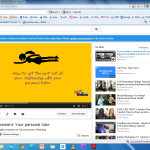I gained an insight recently into a new benefit that we might all derive from screencasts. I gave a paper about the role of a placement tutor and, in particular, how the skills we develop as personal tutors have to be adapted to suit the role of placement tutor. I did not know anyone at the conference, and I was given the dreaded after lunch slot, so I knew I would need to keep everyone interested, or at least awake!
With these considerations in mind, I chose to show the audience, after some initial preamble, an animated screencast that I have made for my students, showing them how our academic placement scheme in English Literature works. (The screencast is in the GRASS screencast bank on this site.)

What happened next was rather unexpected. During the few minutes of the screencast I saw shoulders relax. Some people smiled. A couple even laughed at some humorous animation on one of the slides. Nobody – nobody at all – looked at me. It was a delight. I could get my bearings whilst they watched, which helped me, but I also realised that this was really helping them. Better than any description I could have given them, this short screencast gave them the student’s eye view on how our placement system works. I felt confident that they knew exactly what I was talking about from then on, and also that they had a sense of how a student might feel during the early part of the journey towards a successful academic placement.
I have used Prezi and PowerPoint at conferences before, and sometime I have just talked to people without a visual aid, but this new experiment has inspired me to use screencasts in this setting in future.
What was perhaps most surprising was the way the audience members reacted during the Q &A session. They did ask me about being a placement tutor, of course, but I also answered several interesting questions about making screencasts and how I felt students might benefit from them. It seems that the appetite for screencasts as a pedagogical tool continues to increase – interesting times lie ahead!














